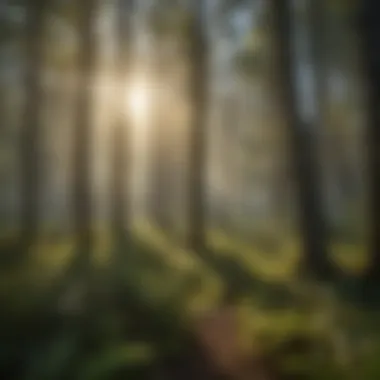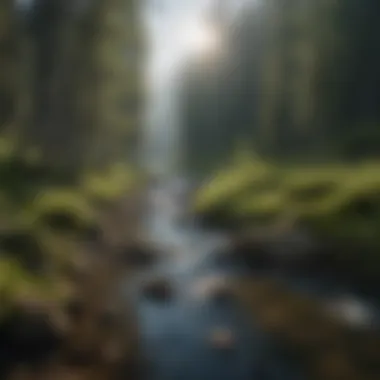Discover the Enchanting Forests of South Central Alaska's Diverse Ecosystems


Evergreen Trees Species
South Central Alaska is a haven for a diverse array of evergreen trees, each with its unique characteristics and importance to the region's rich forests. From the towering spruce trees that dominate the landscape to the hardy junipers scattered across the valleys, exploring these evergreens offers a glimpse into the heart of Alaska's natural beauty.
Types of Evergreen Trees
In South Central Alaska, you will encounter majestic species like the Sitka spruce, Alaska cedar, and western hemlock. These trees not only define the region's scenery but also play a vital role in the local ecosystem, providing shelter and sustenance to numerous wildlife species.
Ecological Significance
The evergreen trees in South Central Alaska contribute significantly to the region's ecological balance. Their dense foliage serves as crucial habitat for birds and small mammals, while their sturdy branches provide nesting sites for various species. Moreover, evergreen trees help regulate the local climate and soil conditions, showcasing their importance in maintaining the delicate ecosystem of the area.
Conservation Practices
Preserving the evergreen tree species in South Central Alaska calls for strategic conservation efforts. Implementing sustainable logging practices, protecting vital wildlife habitats, and promoting reforestation initiatives are key steps in ensuring the long-term survival of these iconic trees and the biodiversity they support.
Overview of South Central Alaska
South Central Alaska offers a mesmerizing blend of rugged geographical features, diverse ecosystems, and captivating beauty, making it a focal point in our exploration of the region. From its majestic mountains and sprawling glaciers to the intricate network of rivers and pristine lakes, South Central Alaska stands as a testament to nature's grandeur and resilience. Understanding the geographical intricacies of this region is vital for grasping the symbiotic relationship between its landscapes and the flora and fauna that call it home.
Geographical Features
Mountains and Glaciers
Mountains and glaciers serve as prominent icons of South Central Alaska, shaping its topography and influencing its climatic patterns. The towering peaks of the Chugach and Alaska Mountain Ranges stand as guardians of the land, their snow-capped summits glistening under the Arctic sun. Glaciers like the Matanuska Glacier showcase millennia of geological transformation, offering a glimpse into the region's ever-evolving landscape. The unique feature of glacial retreat provides valuable insights into climate change impacts, making it a pivotal focus in our exploration.
Rivers and Lakes
The rivers and lakes of South Central Alaska form a vital network that sustains life within the region. Rivers like the Kenai and Copper River flow with vigor, carving through valleys and providing crucial habitats for diverse wildlife. Lakes such as Eklutna Lake shimmer with pristine beauty, reflecting the surrounding forests and mountains with crystal clarity. Understanding the role of these water bodies in ecosystem dynamics is crucial for appreciating the delicate balance of South Central Alaska's natural environment.
Valleys and Fjords
Valleys and fjords add a layer of complexity to South Central Alaska's geography, offering sheltered havens and breathtaking scenery. Valleys like the Mat-Su Valley cradle lush forests and meandering rivers, inviting exploration and showcasing the region's fertility. Fjords such as the Kenai Fjords National Park reveal dramatic landscapes forged by ancient glacial processes, harboring a rich tapestry of marine life. The interplay between valleys and fjords encapsulates the essence of South Central Alaska's natural diversity and ecological resilience.
Climate and Weather Patterns
Seasonal Variations
Seasonal variations play a pivotal role in shaping the landscapes and biodiversity of South Central Alaska. The transition between long winter nights and endless summer days dictates the rhythm of life in this region, influencing everything from plant growth to animal migrations. Understanding the nuances of these seasonal changes is paramount for comprehending the adaptive strategies of South Central Alaska's flora and fauna in the face of extreme climatic shifts.
Effect on Flora and Fauna
The climate and weather patterns of South Central Alaska exert a profound influence on its flora and fauna, dictating their distribution and behavior. Tundra plants like dwarf shrubs adapt to the harsh Arctic conditions, showcasing remarkable resilience in the face of adversity. Similarly, iconic wildlife species like the moose and bald eagle demonstrate unique adaptations to thrive in this challenging environment. Exploring the interplay between climate and biodiversity unveils the intricate web of life that defines South Central Alaska's ecological fabric.
Biodiversity


Plant Species
The plant species of South Central Alaska embody a rich tapestry of adaptation and diversity, reflecting the region's unique ecological niches. Coniferous forests dominated by spruce and hemlock species blanket the landscape, offering shelter and sustenance to a myriad of wildlife. Deciduous species like birch trees add a splash of autumnal hues to the forest canopy, signaling the changing seasons. Delving into the intricate world of plant species unveils the intricate web of dependencies that sustain South Central Alaska's vibrant ecosystems.
Animal Species
Animal species in South Central Alaska represent a diverse array of terrestrial and avian life, each playing a vital role in the region's ecological balance. Grizzly bears roam the vast wilderness with a majestic presence, embodying the spirit of untamed nature. Moose, with their imposing antlers and gentle demeanor, symbolize the resilience and adaptability required to thrive in this wilderness. Bald eagles soar through the skies with grace and precision, embodying the region's connection to the wild and untamed.
Endangered Species
Endangered species in South Central Alaska paint a poignant picture of conservation challenges and the urgent need for protection and preservation. Species like the Stellar sea lion and northern sea otter face threats from habitat loss and human disturbances, underscoring the delicate balance between development and conservation. Understanding the plight of these endangered species sheds light on the intricate web of ecological interdependencies at play in South Central Alaska, urging us to take collective action to ensure their survival and the preservation of the region's biodiversity.
Forests of South Central Alaska
In the exploration of South Central Alaska's rich landscapes, the forests play a pivotal role in shaping the region's ecosystem diversity and ecological importance. These forests, ranging from boreal to temperate rainforests and alpine tundra, form the heart of this article, highlighting their significance in sustaining local flora and fauna. The lush forests of South Central Alaska not only provide habitats for a plethora of plant and animal species but also contribute to the region's overall allure and natural beauty.
Types of Forests
Boreal Forests
Delving into the vast expanse of boreal forests in South Central Alaska unveils a world characterized by coniferous trees, such as spruce and fir, creating a dense canopy. These forests are crucial for carbon sequestration, playing a pivotal role in mitigating climate change. The unique feature of boreal forests lies in their resilience to harsh climates, making them an essential component of the region's ecosystem. While these forests offer tremendous biodiversity, they are also susceptible to ecological disturbances like wildfires and logging, which impact their sustainability.
Temperate Rainforests
The enchanting temperate rainforests of South Central Alaska showcase a unique blend of lush greenery and abundant rainfall. Their key characteristic lies in the significant precipitation that fuels the region's rich biodiversity. These forests provide vital habitats for various wildlife species and contribute to the overall health of the ecosystem. Despite their benefits, temperate rainforests face challenges such as deforestation and habitat fragmentation, highlighting the delicate balance required for their conservation.
Alpine Tundra
Ascending to the alpine tundra regions of South Central Alaska unveils a stark yet captivating landscape characterized by low-lying vegetation and harsh climate conditions. The key characteristic of alpine tundra lies in its adaptability to extreme temperatures and high altitudes, supporting specialized plant species unique to these environments. While alpine tundra ecosystems are resilient, they are vulnerable to human impact and climate change, necessitating conservation efforts to preserve their delicate balance.
Forest Ecosystems
Role in Carbon Sequestration
The critical role of South Central Alaska's forests in carbon sequestration cannot be overstated, as these ecosystems act as significant carbon sinks, helping mitigate the impacts of greenhouse gas emissions. Their key characteristic lies in their ability to absorb and store carbon dioxide, playing a crucial role in combating climate change. However, factors such as deforestation and land degradation can compromise their carbon sequestration potential, emphasizing the importance of sustainable forest management.
Wildlife Habitats
The forest ecosystems of South Central Alaska serve as vital wildlife habitats, providing shelter and sustenance for a diverse array of species, including bears, moose, and bald eagles. Their key characteristic lies in promoting biodiversity and supporting intricate food webs that contribute to ecosystem resilience. While these habitats offer sanctuary for wildlife, they are increasingly threatened by habitat loss and human encroachment, underscoring the need for conservation measures to protect these essential ecosystems.
Human Impact
Human activities exert a significant impact on South Central Alaska's forest ecosystems, influencing biodiversity, water quality, and air purity. The key characteristic of human impact in these forests is the dual role of both benefiting from and endangering the environment through activities such as logging, infrastructure development, and tourism. While human presence can enhance conservation awareness and support, it also poses challenges in maintaining ecological balance and sustainability, necessitating responsible environmental stewardship.
Forest Management Practices
Sustainable Logging


The practice of sustainable logging in South Central Alaska involves harvesting timber in a manner that ensures long-term forest health and regeneration. Its key characteristic lies in balancing economic gains with ecological preservation, promoting selective logging methods that minimize environmental degradation. Sustainable logging offers a method to access forest resources while safeguarding ecosystem integrity, although challenges such as monitoring compliance and illegal logging persist, necessitating robust management strategies
Conservation Efforts
Conservation efforts in South Central Alaska focus on preserving the region's unique ecosystems through habitat restoration, protected areas establishment, and endangered species protection. The key characteristic of conservation efforts is their holistic approach to ecosystem conservation, encompassing diverse stakeholders and strategies to promote biodiversity and sustainability. These efforts aim to mitigate human impacts, restore degraded habitats, and educate the community on the importance of conservation, fostering a harmonious relationship between humans and nature.
Community Involvement
Community involvement plays a crucial role in South Central Alaska's forest conservation, engaging local residents, organizations, and government entities in environmental stewardship initiatives. Its key characteristic lies in fostering grassroots participation and collective action towards sustaining forest ecosystems for future generations. By actively involving communities in decision-making processes, conservation projects, and environmental education, a sense of environmental responsibility and stewardship is cultivated, enhancing the resilience and longevity of South Central Alaska's forests.
Exploration And Adventure In South Central Alaska
Exploration and adventure in South Central Alaska are paramount in this article, aligning perfectly with the region's astounding beauty and biodiversity. The allure of embarking on nature trails and engaging with the wildlife captivates both seasoned explorers and casual visitors. The exploration aspect allows individuals to immerse themselves in the natural surroundings, gaining a firsthand experience of the rich forests that define South Central Alaska. Adventure, on the other hand, adds an element of excitement and challenge to the journey, making each expedition a memorable and thrilling escapade.
Hiking Trails
Chugach State Park
Chugach State Park stands as a quintessential destination for hiking enthusiasts within South Central Alaska. With its extensive trail network offering varying levels of difficulty, Chugach State Park caters to hikers of all skill levels. The park's proximity to Anchorage and its accessibility make it a popular choice for locals and tourists alike. One key characteristic of Chugach State Park is its diverse terrain, featuring pristine lakes, dense forests, and soaring peaks. This diversity provides hikers with a range of landscapes to explore and admire. However, due to its popularity, congestion during peak seasons can be a drawback for those seeking a quieter hiking experience.
Kenai Fjords National Park
Kenai Fjords National Park presents a unique aspect of exploration in South Central Alaska with its blend of ice, wildlife, and marine ecosystems. The park's highlight is undoubtedly its tidewater glaciers, offering visitors a rare glimpse into the dynamic world of glacial formations. Wildlife sightings, including whales and seabirds, further enrich the hiking experience, creating unforgettable encounters with nature. The rugged beauty of Kenai Fjords National Park appeals to adventurers seeking a more remote and rugged environment. However, the park's vastness can pose challenges for hikers looking to cover multiple areas within a limited timeframe.
Denali National Park
Denali National Park epitomizes the untamed wilderness of South Central Alaska, showcasing the iconic Denali (Mount McKinley), North America's tallest peak. Hikers drawn to Denali National Park yearn for a rugged wilderness experience amidst sweeping tundra, braided rivers, and alpine ranges. The park's remoteness and expansive landscapes provide ample opportunities for solitude and introspection. A key characteristic of Denali National Park is its unpredictable weather, necessitating preparedness and adaptability from hikers. While the park's vast size allows for exploration for days on end, its remoteness can be a double-edged sword for those seeking quick access to amenities.
Wildlife Viewing
Bears
Bears hold a special place in the wildlife viewing experience of South Central Alaska, with species such as grizzly bears and black bears roaming the forests and mountains. The opportunity to observe these majestic creatures in their natural habitat serves as a high point for many visitors. Understanding bear behavior and habitat preferences enhances the viewing experience, providing insights into these iconic residents of Alaska. However, the need for bear safety protocols and awareness of potential encounters underscores the importance of responsible wildlife viewing practices.
Moose
Moose, with their towering stature and distinct antlers, grace the wilderness of South Central Alaska, captivating onlookers with their grace and power. Observing moose in their natural habitat offers a glimpse into their feeding habits and social dynamics, adding depth to the wildlife viewing experience. The abundance of moose in the region provides ample opportunities for sightings, enriching the overall exploration of the Alaskan wilderness. However, moose encounters require caution due to their size and potential territorial behavior.
Bald Eagles
Bald eagles, as symbols of strength and freedom, soar across the skies of South Central Alaska, captivating audiences with their aerial maneuvers and hunting prowess. Witnessing bald eagles in their natural habitat offers a window into their ecosystem role and conservation significance. The bald eagle's iconic presence enriches the wildlife viewing experience, instilling a sense of awe and reverence for these magnificent birds. However, eagle sightings may require patience and keen observation skills to spot these elusive creatures in their natural surroundings.
Outdoor Activities
Fishing
Fishing in the rivers and lakes of South Central Alaska holds a special allure for outdoor enthusiasts seeking to reel in prized catches such as salmon and trout. The region's abundant freshwater resources provide ample opportunities for anglers to test their skills against the bounty of Alaskan waters. The thrill of a successful catch amidst the serene wilderness adds a rewarding dimension to the outdoor experience. However, fluctuating fish populations and conservation concerns necessitate responsible fishing practices to maintain the ecological balance of the region.


Kayaking
Kayaking along the fjords and coastal waters of South Central Alaska offers adventurers a unique perspective on the region's rugged coastline and marine life. The tranquility of gliding through pristine waters under the vast Alaskan skies immerses kayakers in the untamed beauty of the landscape. Close encounters with marine creatures such as sea otters and seals enhance the kayaking experience, creating lasting memories of coastal exploration. However, the unpredictable weather and challenging water conditions add an element of thrill and unpredictability to the adventure.
Backpacking
Backpacking through the backcountry of South Central Alaska allows explorers to traverse uncharted landscapes and remote wilderness areas. The freedom of carrying all essentials on one's back fosters a sense of self-sufficiency and immersion in the natural surroundings. The solitude and connection with nature experienced during backpacking trips offer introspective moments and personal growth opportunities. However, rugged terrains and variable weather conditions necessitate careful planning and preparation to ensure a safe and fulfilling backpacking experience.
Conservation Efforts and Preservation Projects
In the enthralling realm of South Central Alaska's rich forests, Conservation Efforts and Preservation Projects stand as beacons of hope and sustainability. These initiatives play a pivotal role in safeguarding the diverse ecosystems and pristine landscapes that define this region. By focusing on specific elements such as reforestation, habitat conservation, and environmental stewardship, Conservation Efforts and Preservation Projects ensure the longevity and vitality of South Central Alaska's natural heritage.
National Parks and Reserves
Wrangell-St. Elias National Park
Wrangell-St. Elias National Park epitomizes grandeur and vastness, being the largest national park in the United States. Its rugged mountains, expansive glaciers, and unique biodiversity make it a cornerstone of conservation in South Central Alaska. The park's key characteristic lies in its size and untamed wilderness, offering a sanctuary for diverse species and providing invaluable research opportunities. Wrangell-St. Elias National Park's remote location presents challenges in accessibility but ensures a wilderness experience truly unparalleled.
Kenai National Wildlife Refuge
Nestled in the heart of South Central Alaska, Kenai National Wildlife Refuge embraces a mosaic of habitats ranging from coastal wetlands to alpine tundra. Its key characteristic lies in its role as a crucial habitat for salmon, bears, and migratory birds, attracting nature enthusiasts and researchers alike. The refuge's unique feature is its balance between wildlife conservation and outdoor recreation, making it a popular choice for eco-tourism and wilderness exploration.
Chugach National Forest
As the second-largest national forest in the United States, Chugach National Forest sprawls across diverse landscapes from coastal rainforests to alpine meadows. Its key characteristic lies in its accessibility and proximity to urban centers like Anchorage, making it a vital green space for recreational activities and conservation efforts. The forest's unique feature is its significance as a carbon sink and wildlife corridor, providing essential ecosystem services and serving as a haven for wildlife.
Reforestation Initiatives
Tree-Planting Programs
Tree-Planting Programs play a fundamental role in reestablishing forest cover and enhancing biodiversity in South Central Alaska. By planting native tree species and restoring damaged habitats, these initiatives contribute to carbon sequestration and ecosystem resilience. The key characteristic of Tree-Planting Programs is their tangible impact on landscape restoration and community engagement, fostering a sense of environmental stewardship and empowerment.
Forest Regeneration Techniques
Forest Regeneration Techniques encompass a suite of practices aimed at enhancing natural regeneration and accelerating forest recovery. From controlled burns to selective logging, these techniques play a crucial role in restoring disturbed ecosystems and promoting sustainable forest management. The key characteristic of Forest Regeneration Techniques is their adaptability to different forest types and environmental conditions, ensuring the long-term health and vitality of South Central Alaska's forests
Community Volunteer Projects
Community Volunteer Projects form the backbone of conservation efforts in South Central Alaska, mobilizing local communities to participate in tree-planting, trail maintenance, and wildlife monitoring. These projects not only foster a sense of ownership and connection to the land but also promote environmental awareness and community resilience. The key characteristic of Community Volunteer Projects is their ability to bridge the gap between conservation organizations and the public, creating a sense of shared responsibility and stewardship.
Climate Change Adaptation
Impact on Forests
The impact of climate change on forests in South Central Alaska poses significant challenges to biodiversity, ecosystem functioning, and wildfire susceptibility. Changing precipitation patterns, temperature extremes, and pest outbreaks have dire consequences for tree species and wildlife populations. The key characteristic of the impact on forests is its far-reaching effects on ecosystem dynamics and species distribution, underscoring the urgency of adaptive management and mitigation strategies.
Mitigation Strategies
Mitigation Strategies are essential pathways to reduce the negative impacts of climate change on South Central Alaska's forests. From promoting sustainable land management practices to enhancing forest resilience through silvicultural interventions, these strategies aim to safeguard ecosystem services and enhance carbon sequestration. The key characteristic of Mitigation Strategies is their proactive approach to addressing climate change impacts, emphasizing a blend of adaptive capacity and ecosystem sustainability.
Research and Monitoring
Research and Monitoring initiatives play a crucial role in understanding the response of South Central Alaska's forests to climate change and informing adaptive management decisions. By monitoring key indicators such as tree growth, species diversity, and carbon fluxes, researchers can assess ecosystem health and inform future conservation strategies. The key characteristic of Research and Monitoring is its role in bridging science and policy, providing data-driven insights that guide effective climate change adaptation and forest management practices.



